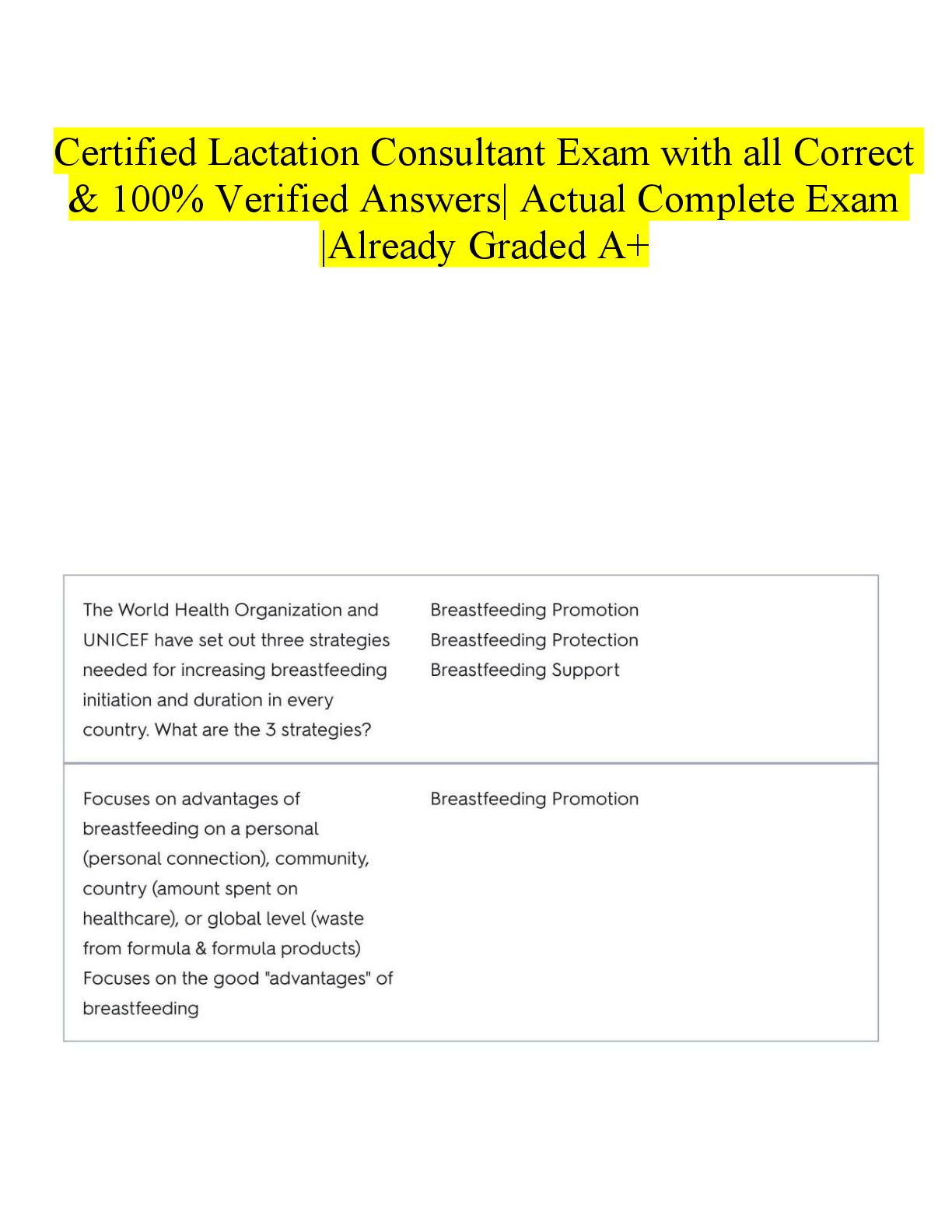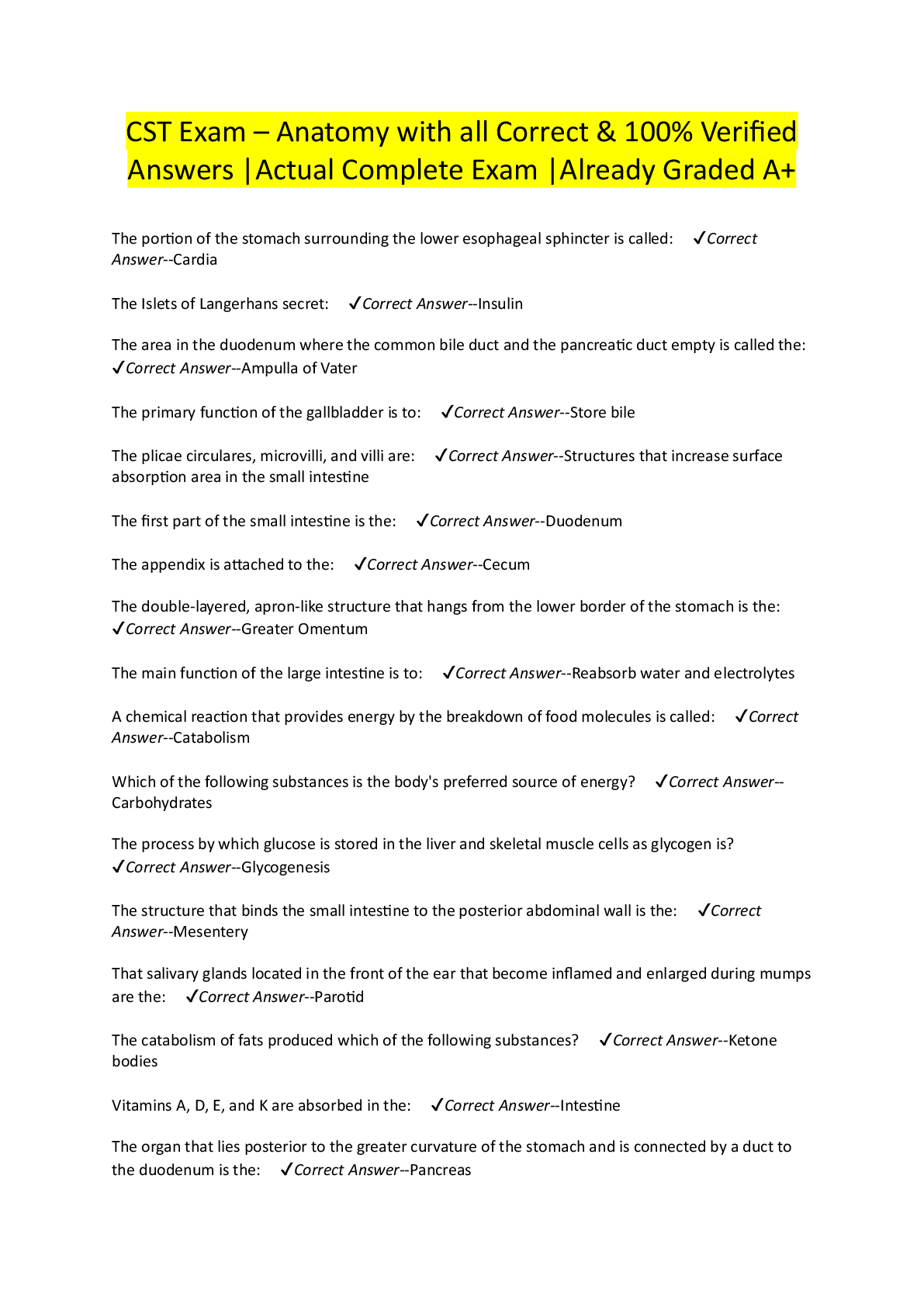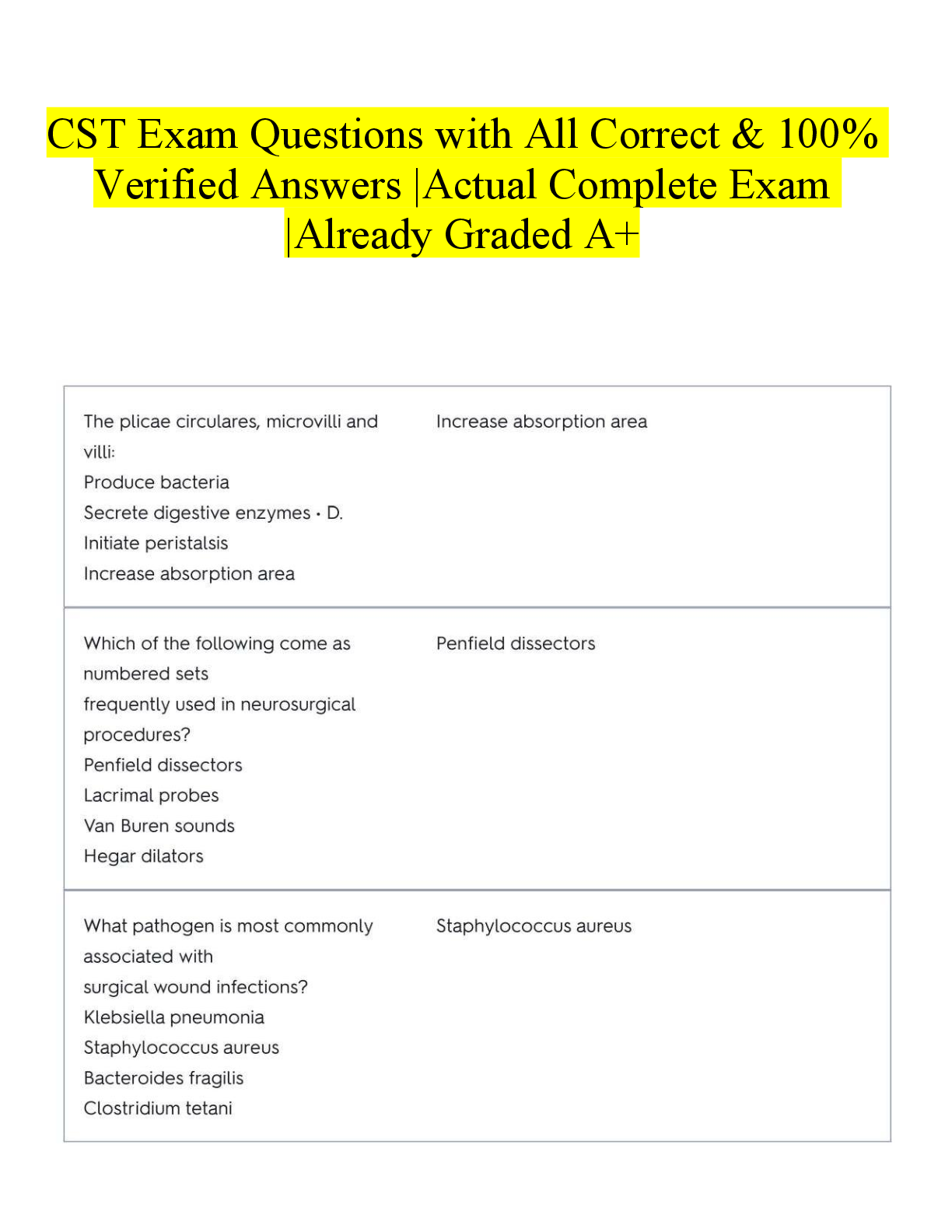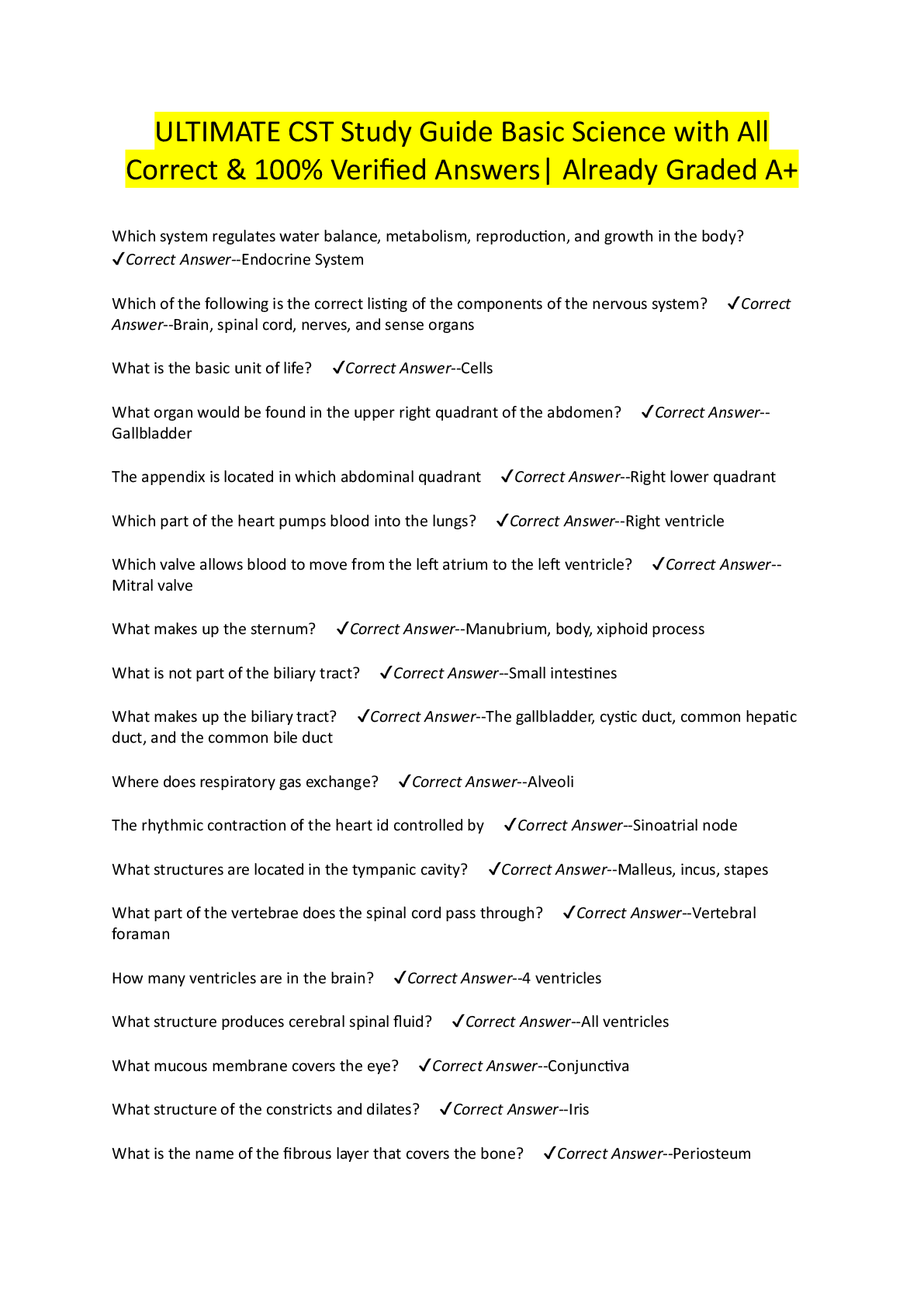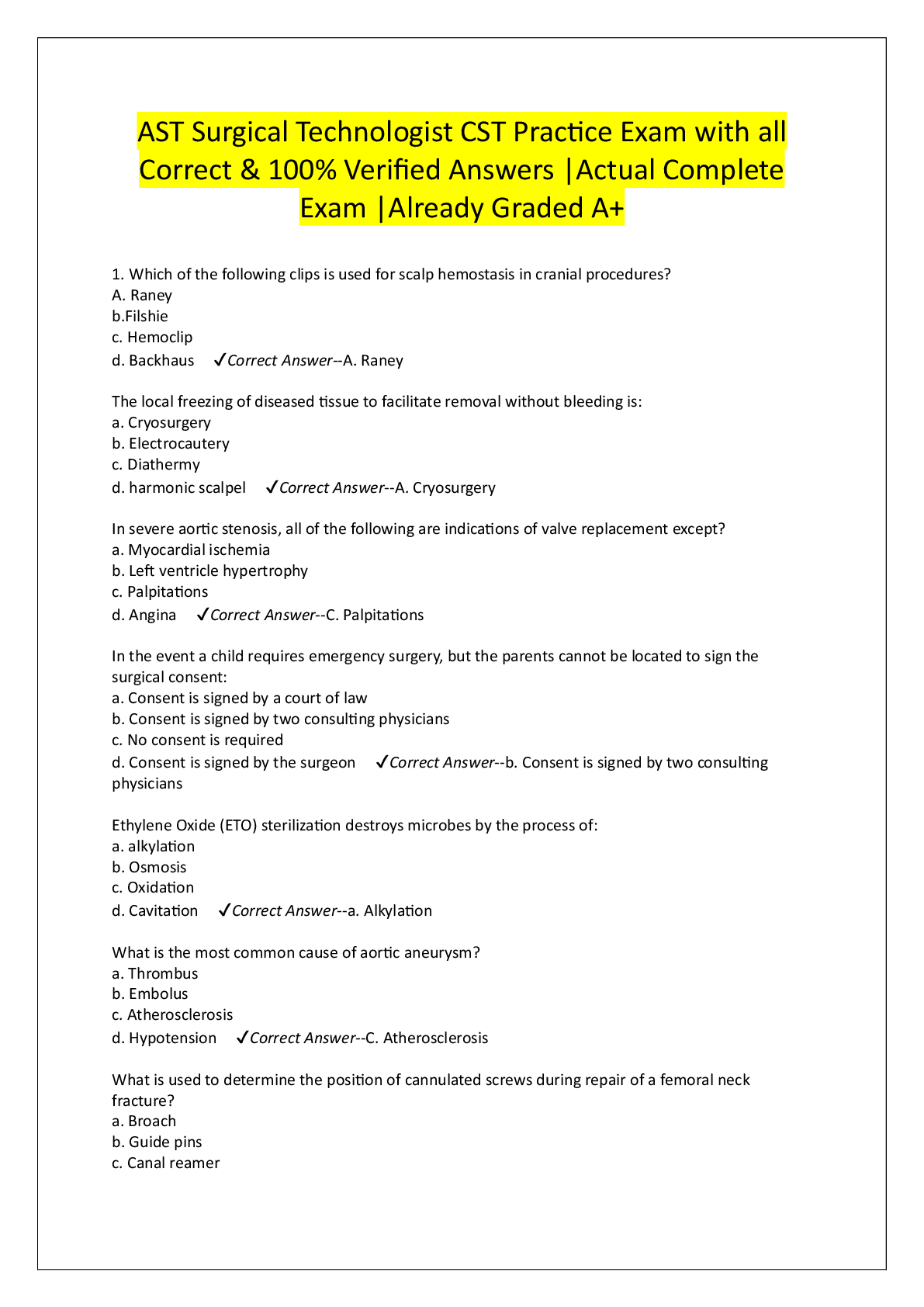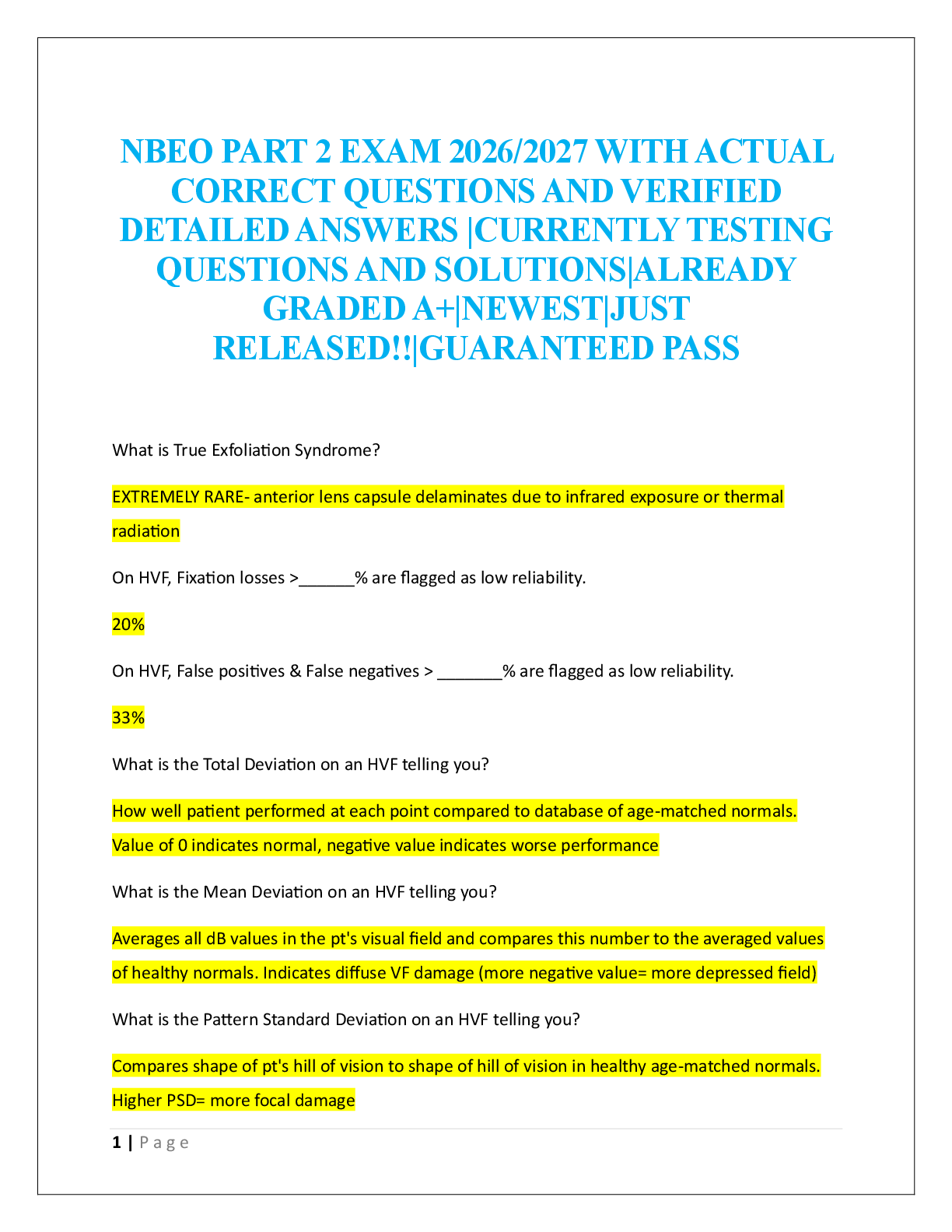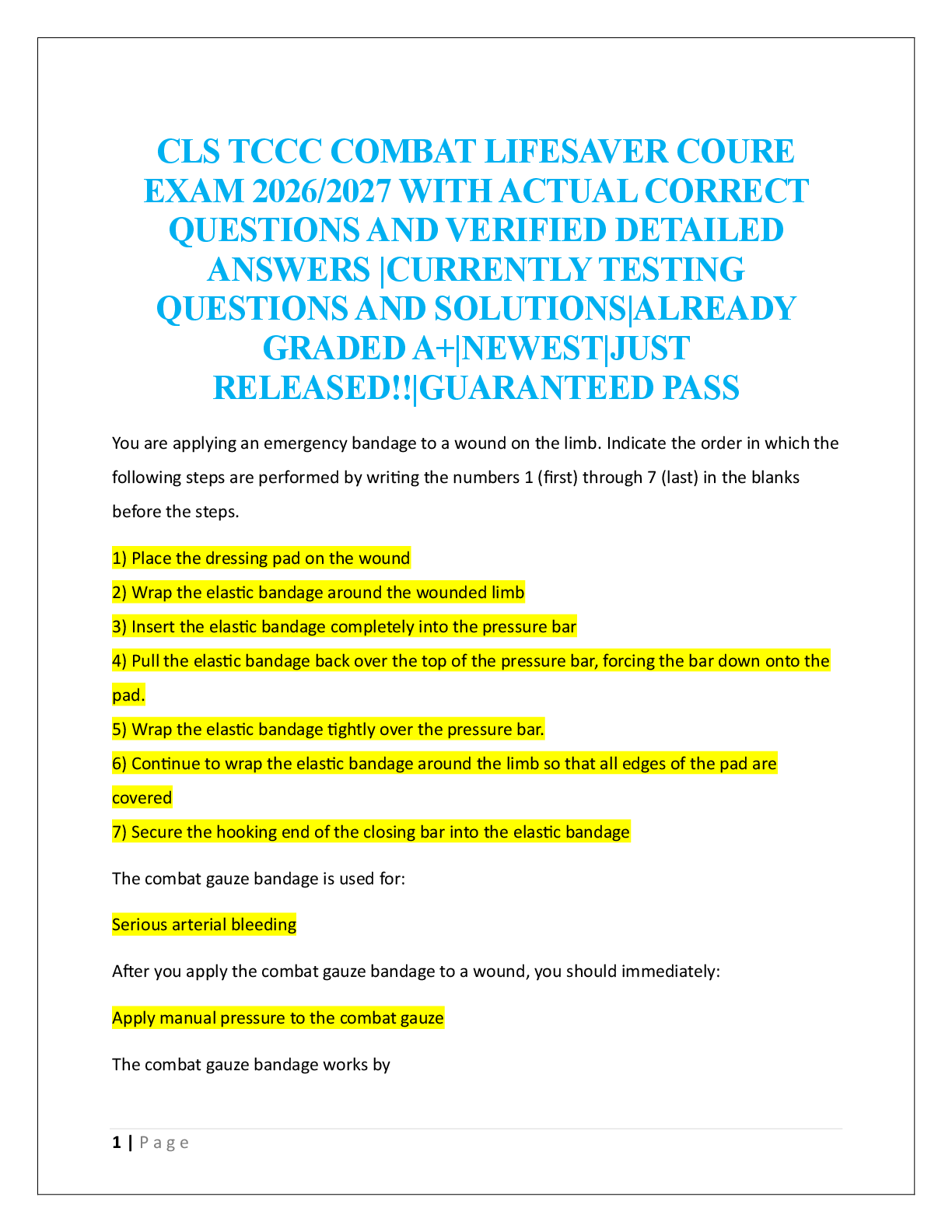*NURSING > EXAM > NURSING 1950 Mental Health Module 5 (GRADED A+) Questions and Answers Solution/ 100% Guaranteed Pass (All)
NURSING 1950 Mental Health Module 5 (GRADED A+) Questions and Answers Solution/ 100% Guaranteed Pass
Document Content and Description Below
NURSING 1950 Mental Health Module 5 (GRADED A+) Questions and Answers Solution 1. A person has had difficulty keeping a job because of arguing with co-workers and accusing them of conspirac ... y. Today the person shouts, "They're all plotting to destroy me. Isn't that true?" Select the nurse's most therapeutic response. "Feeling that people want to destroy you must be very frightening." Resist focusing on content instead, focus on the feelings the patient is expressing. This strategy prevents arguing about the reality of delusional beliefs. Such arguments increase patient anxiety and the tenacity with which the patient holds to the delusion. 2. A newly admitted patient diagnosed with schizophrenia is hypervigilant and constantly scans the environment. The patient states, "I saw two doctors talking in the hall. They were plotting to kill me." The nurse may correctly assess this behavior as: an idea of reference Ideas of reference are misinterpretations of the verbalizations or actions of others that give special personal meanings to these behaviors for example, when seeing two people talking, the individual assumes they are talking about him or her. 3. A patient diagnosed with schizophrenia says, "My co-workers are out to get me. I also saw two doctors plotting to kill me." How does this patient perceive the environment? Dangerous The patient sees the world as hostile and dangerous. This assessment is important because the nurse can be more effective by using empathy to respond to the patient. 4. When a patient diagnosed with schizophrenia was discharged 6 months ago, haloperidol (Haldol) was prescribed. The patient now says, "I stopped taking those pills. They made me feel like a robot." What are common side effects the nurse should validate with the patient? Sedation and muscle stiffness Typical antipsychotic drugs often produce sedation and extrapyramidal side effects such as stiffness and gait disturbance, effects the patient might describe as making him or her feel like a "robot." 5. Which hallucination necessitates the nurse to implement safety measures? The patient says, "The voices say everyone is trying to kill me." The correct response indicates the patient is experiencing paranoia. Paranoia often leads to fearfulness, and the patient may attempt to strike out at others to protect self. 6. A patient's care plan includes monitoring for auditory hallucinations. Which assessment findings suggest the patient may be hallucinating? Darting eyes, tilted head, mumbling to self Clues to hallucinations include eyes looking around the room as though to find the speaker, tilting the head to one side as though listening intently, and grimacing, mumbling, or talking aloud as though responding conversationally to someone. 7. A health care provider considers which antipsychotic medication to prescribe for a patient diagnosed with schizophrenia who has auditory hallucinations and poor social function. The patient is also overweight and hypertensive. Which drug should the nurse advocate? aripiprazole (Abilify) Aripiprazole is a third-generation atypical antipsychotic effective against both positive and negative symptoms of schizophrenia. It causes little or no weight gain and no increase in glucose, high- or low-density lipoprotein cholesterol, or triglycerides, making it a reasonable choice for a patient with obesity or heart disease. 8. A patient diagnosed with schizophrenia tells the nurse, "I eat skiller. Tend to end. Easter. It blows away. Get it?" Select the nurse's best response. "I am having difficulty understanding what you are saying." When a patient's speech is loosely associated, confused, and disorganized, pretending to understand is useless. The nurse should tell the patient that he or she is having difficulty understanding what the patient is saying. If a theme is discernible, ask the patient to talk about the theme. 9. A patient diagnosed with schizophrenia exhibits little spontaneous movement and demonstrates waxy flexibility. Which patient needs are of priority importance? Physiological Physiological needs must be met to preserve life. A patient with waxy flexibility must be fed by hand or tube, toileted, given range-of-motion exercises, and so forth to preserve physiological integrity. 10. A patient diagnosed with schizophrenia demonstrates little spontaneous movement and has waxy flexibility. The patient's activities of daily living are severely compromised. An appropriate outcome would be that the patient will: perform self-care activities with coaching by the end of day 3 Outcomes related to self-care deficit nursing diagnoses should deal with increasing ability to perform self-care tasks independently, such as feeding, bathing, dressing, and toileting. Performing the tasks with coaching by nursing staff denotes improvement over the complete inability to perform the tasks. 11. A nurse observes a catatonic patient standing immobile, facing the wall with one arm extended in a salute. The patient remains immobile in this position for 15 minutes, moving only when the nurse gently lowers the arm. What is the name of this phenomenon? Waxy flexibility Waxy flexibility is the ability to hold distorted postures for extended periods of time, as though the patient were molded in wax. 12. A patient is experiencing delusions of persecution about being poisoned. The patient has refused all hospital meals for 3 days. Which intervention is most likely to be acceptable to the patient? Allowing the patient supervised access to food vending machines The patient who is delusional about food being poisoned is likely to believe restaurant food might still be poisoned and to say that the staff member tasting the food has taken an antidote to the poison before tasting. 13. A community mental health nurse wants to establish a relationship with a very withdrawn patient diagnosed with schizophrenia. The patient lives at home with a supportive family. Select the nurse's best plan. Visit daily for 4 days, then every other day for 1 week stay with patient for 20 minutes, accept silence state when the nurse will return. Severe constraints on the community mental health nurse's time will probably not allow more time than what is mentioned in the correct option yet, important principles can be used. A severely withdrawn patient should be met "at the patient's own level," with silence accepted. Short periods of contact are helpful to minimize both the patient's and the nurse's anxiety. Predictability in returning as stated will help build trust. 14. Withdrawn patients diagnosed with schizophrenia: avoid relationships because they become anxious with emotional closeness When an individual is suspicious and distrustful and perceives the world and the people in it as potentially dangerous, withdrawal into an inner world can be a defense against uncomfortable levels of anxiety. When someone attempts to establish a relationship with such a patient, the patient's anxiety rises until trust is established. 15. A newly admitted patient diagnosed with schizophrenia says, "The voices are bothering me. They yell and tell me I am bad. I have got to get away from them." Select the nurse's most helpful reply. "I'll stay with you. Focus on what we are talking about, not the voices. " Staying with a distraught patient who is hearing voices serves several purposes: ongoing observation, the opportunity to provide reality orientation, a means of helping dismiss the voices, the opportunity of forestalling an action that would result in self-injury, and general support to reduce anxiety. 16. A patient diagnosed with schizophrenia has taken fluphenazine (Prolixin) 5 mg po bid for 3 weeks. The nurse now observes a shuffling propulsive gait, a mask-like face, and drooling. Which term applies to these symptoms? Pseudoparkinsonism Pseudoparkinsonism induced by antipsychotic medication mimics the symptoms of Parkinson's disease. It frequently appears within the first month of treatment and is more common with first-generation antipsychotic drugs. 17. A patient diagnosed with schizophrenia is very disturbed and violent. After several doses of haloperidol (Haldol), the patient is calm. Two hours later the nurse sees the patient's head rotated to one side in a stiff position, the lower jaw thrust forward, and drooling. Which problem is most likely? An acute dystonic reaction Acute dystonic reactions involve painful contractions of the tongue, face, neck, and back. Opisthotonos and oculogyric crisis may be observed. Dystonic reactions are considered emergencies requiring immediate intervention. 18. An acutely violent patient diagnosed with schizophrenia receives several doses of haloperidol (Haldol). Two hours later the nurse notices the patient's head rotated to one side in a stiffly fixed position, the lower jaw thrust forward, and drooling. Which intervention by the nurse is indicated? Administer diphenhydramine (Benadryl) 50 mg IM from the PRN medication administration record Diphenhydramine, trihexyphenidyl, benztropine, and other anticholinergic medications may be used to treat dystonias. Swallowing will be difficult or impossible therefore, oral medication is not an option. 19. A patient took trifluoperazine 30 mg po daily for 3 years. The clinic nurse notes that the patient grimaces and constantly smacks both lips. The patient's neck and shoulders twist in a slow, snakelike motion. Which problem would the nurse suspect? Tardive dyskinesia Tardive dyskinesia is a neuroleptic-induced condition involving the face, trunk, and limbs. Involuntary movements, such as tongue thrusting licking, blowing, irregular movements of the arms, neck, and shoulders, rocking, hip jerks and pelvic thrusts, are seen. These symptoms are frequently not reversible even when the drug is discontinued. 20. A nurse sits with a patient diagnosed with schizophrenia. The patient starts to laugh uncontrollably, although the nurse has not said anything funny. Select the nurse's best response. "You're laughing. Tell me what's happening." The patient is likely laughing in response to inner stimuli, such as hallucinations or fantasy. Focus on the hallucinatory clue (the patient's laughter) and then elicit the patient's observation. 21. The nurse assesses a patient diagnosed with schizophrenia. Which assessment finding would the nurse regard as a negative symptom of schizophrenia? Poor personal hygiene Negative symptoms include apathy, anhedonia, poor social functioning, and poverty of thought. Poor personal hygiene is an example of poor social functioning. 22. What assessment findings mark the prodromal stage of schizophrenia? Withdrawal, misinterpreting, poor concentration, and preoccupation with religion Withdrawal, misinterpreting, poor concentration, and preoccupation with religion are prodromal symptoms, the symptoms that are present before the development of florid symptoms. 23. A patient diagnosed with schizophrenia says, "Contagious bacteria are everywhere. When they get in your body, you will be locked up with other infected people." Which problem is evident? Paranoia The patient's unrealistic fear of harm indicates paranoia. 24. A patient diagnosed with schizophrenia begins a new prescription for lurasidone HCL (Latuda). The patient is 5'6" and currently weighs 204 lbs. Which topic is most important for the nurse to include in the teaching plan related to this medication? Weight management strategies Lurasidone HCL (Latuda) is a second-generation antipsychotic medication. The incidence of weight gain, diabetes, and high cholesterol is high with this medication. The patient is overweight now, so weight management will be especially important. 25. A patient diagnosed with schizophrenia says, "It's beat. Time to eat. No room for the cat." What type of verbalization is evident? Associative looseness Looseness of association refers to jumbled thoughts incoherently expressed to the listener. 26. A patient diagnosed with schizophrenia has taken a conventional antipsychotic medication for a year. Hallucinations are less intrusive, but the patient continues to have apathy, poverty of thought, and social isolation. The nurse would expect a change to which medication? Olanzapine (Zyprexa) Olanzapine is a second-generation atypical antipsychotic that targets both positive and negative symptoms of schizophrenia. 27. The family of a patient diagnosed with schizophrenia is unfamiliar with the illness and family's role in recovery. Which type of therapy should the nurse recommend? Psychoeducational A psychoeducational group explores the causes of schizophrenia, the role of medication, the importance of medication compliance, support for the ill member, and hints for living with a person with schizophrenia. Such a group can be of immeasurable practical assistance to the family. 28. A patient diagnosed with schizophrenia has been stable for a year however, the family now reports the patient is tense, sleeps 3 to 4 hours per night, and has difficulty concentrating. The patient says, "My computer is sending out infected radiation beams." The nurse can correctly assess this information as an indication of: relapse Signs of potential relapse include feeling tense, difficulty concentrating, trouble sleeping, increased withdrawal, and increased bizarre or magical thinking. 29. A patient diagnosed with schizophrenia begins to talks about "macnabs" hiding in the warehouse at work. The term "macnabs" should be documented as: a neologism A neologism is a newly coined word having special meaning to the patient. "Macnabs" is not a known common word. 30. A patient diagnosed with schizophrenia anxiously says, "I can see the left side of my body merging with the wall, then my face appears and disappears in the mirror." While listening, the nurse should: maintain a normal social interaction distance from the patient The patient is describing phenomena that indicate personal boundary difficulties and depersonalization. The nurse should maintain appropriate social distance and not touch the patient because the patient is anxious about the inability to maintain ego boundaries and merging or being swallowed by the environment. 31. A patient diagnosed with schizophrenia and auditory hallucinations anxiously tells the nurse, "The voice is telling me to do things." Select the nurse's priority assessment question. "What is the voice telling you to do?" Learning what a command hallucination is telling the patient to do is important because the command often places the patient or others at risk for harm. Command hallucinations can be terrifying and may pose a psychiatric emergency. 32. A patient receiving risperidone (Risperdal) reports severe muscle stiffness at 1030. By 1200, the patient has difficulty swallowing and is drooling. By 1600, vital signs are 102.8° F pulse 110 respirations 26 150/90. The patient is diaphoretic. Select the nurse's best analysis and action. Neuroleptic malignant syndrome notify health care provider stat Taking an antipsychotic medication coupled with the presence of extrapyramidal symptoms, such as severe muscle stiffness and difficulty swallowing, hyperpyrexia, and autonomic symptoms (pulse elevation), suggest neuroleptic malignant syndrome, a medical emergency. 33. A nurse asks a patient diagnosed with schizophrenia, "What is meant by the old saying 'You can't judge a book by looking at the cover.'?" Which response by the patient indicates concrete thinking? "The table of contents tells what a book is about." Concrete thinking refers to an impaired ability to think abstractly. Concreteness is often assessed through the patient's interpretation of proverbs. Concreteness reduces one's ability to understand and address abstract concepts such as love or the passage of time. 34. The nurse is developing a plan for psychoeducational sessions for several adults diagnosed with schizophrenia. Which goal is best for this group? Members will: demonstrate improved social skills Improved social skills help patients maintain relationships with others. These relationships are important to management of the disorder. 35. A client says, "Facebook has a new tracking capacity. If I use the Internet, Homeland Security will detain me as a terrorist." Select the nurse's best initial action. Tell the client, "You are in a safe place where you will be helped." The patient is experiencing paranoia and delusional thinking, which leads to fear. Explaining that the patient is in a safe place will help relieve the fear. 36. Which finding constitutes a negative symptom associated with schizophrenia? Poverty of thought Negative symptoms include apathy, anhedonia, poor social functioning, and poverty of thought. 37. A patient insistently states, "I can decipher codes of DNA just by looking at someone." Which problem is evident? Magical thinking Magical thinking is evident in the patient's appraisal of his own abilities. 38. A newly hospitalized patient experiencing psychosis says, "Red chair out town board." Which term should the nurse use to document this finding? Word salad Word salad (schizophasia) is a jumble of words that is meaningless to the listener and perhaps to the speaker as well, because of an extreme level of disorganization. 39. A nurse at the mental health clinic plans a series of psychoeducational groups for persons newly diagnosed with schizophrenia. Which two topics take priority? -"The importance of taking your medication correctly" -"Ways to quit smoking" Stabilization is maximized by adherence to the antipsychotic medication regimen. Because so many persons with schizophrenia smoke cigarettes, this topic relates directly to the patients' physiological well-being. 40. A patient diagnosed with schizophrenia was hospitalized after arguing with co-workers and threatening to harm them. The patient is aloof, suspicious, and says, "Two staff members I saw talking were plotting to kill me." Based on data gathered at this point, which nursing diagnoses relate? Select all that apply. -Risk for other-directed violence -Disturbed thought processes Delusions of persecution and ideas of reference support the nursing diagnosis of disturbed thought processes. Risk for other-directed violence is substantiated by the patient's feeling endangered by persecutors. Fearful individuals may strike out at perceived persecutors or attempt self-harm to get away from persecutors. 41. A person was online continuously for over 24 hours, posting rhymes on official government web-sites and inviting politicians to join social networks. The person has not slept or eaten for 3 days. What features of mania are evident? Poor judgment and hyperactivity Hyperactivity (activity without sleep) and poor judgment (posting rhymes on government web-sites) are characteristic of manic episodes. 42. A patient diagnosed with bipolar disorder is dressed in a red leotard and bright scarves. The patient twirls and shadow boxes. The patient says gaily, "Do you like my scarves? Here; they are my gift to you." How should the nurse document the patient's mood? Euphoric The patient has demonstrated clang associations and pleasant, happy behavior. Excessive happiness indicates euphoria. 43. A person was directing traffic on a busy street, rapidly shouting, "To work, you jerk, for perks" and making obscene gestures at cars. The person has not slept or eaten for 3 days. Which assessment findings will have priority concern for this patient's plan of care? Hyperactivity; not eating and sleeping Hyperactivity, poor nutrition, hydration, and not sleeping take priority in terms of the needs listed above because they threaten the physical integrity of the patient. 44. A patient diagnosed with acute mania has distributed pamphlets about a new business venture on a street corner for 2 days. Which nursing diagnosis has priority? Risk for injury Although each of the nursing diagnoses listed is appropriate for a patient having a manic episode, the priority lies with the patient's physiological safety. Hyperactivity and poor judgment put the patient at risk for injury. 45. A patient diagnosed with bipolar disorder becomes hyperactive after discontinuing lithium. The patient threatens to hit another patient. Which comment by the nurse is appropriate? "Do not hit anyone. If you are unable to control yourself, we will help you." When the patient is unable to control his or her behavior and violates or threatens to violate the rights of others, limits must be set in an effort to deescalate the situation. Limits should be set in simple, concrete terms. 46. This nursing diagnosis applies to a patient with acute mania: Imbalanced nutrition: less than body requirements related to insufficient caloric intake and hyperactivity as evidenced by 5-pound weight loss in 4 days. Select an appropriate outcome. The patient will: drink six servings of a high-calorie, high-protein drink each day High-calorie, high-protein food supplements will provide the additional calories needed to offset the patient's extreme hyperactivity. 47. A patient demonstrating characteristics of acute mania relapsed after discontinuing lithium. New orders are written to resume lithium twice daily and begin olanzapine (Zyprexa). What is the rationale for the addition of olanzapine to the medication regimen? It will: bring hyperactivity under rapid control Manic symptoms are controlled by lithium only after a therapeutic serum level is attained. Because this takes several days to accomplish, a drug with rapid onset is necessary to reduce the hyperactivity initially. 48. A patient diagnosed with bipolar disorder has rapidly changing mood cycles. The health care provider prescribes an anticonvulsant medication. To prepare teaching materials, which drug should the nurse anticipate will be prescribed? carbamazepine (Tegretol) Some patients with bipolar disorder, especially those who have only short periods between episodes, have a favorable response to the anticonvulsants carbamazepine and valproate. Carbamazepine seems to work better in patients with rapid cycling and in severely paranoid, angry manic patients. 49. The exact cause of bipolar disorder has not been determined; however, for most patients: several factors, including genetics, are implicated The best explanation at this time is that bipolar disorder is most likely caused by interplay of complex independent variables. Various theories implicate genetics, endocrine imbalance, environmental stressors, and neurotransmitter imbalances. 50. The spouse of a patient diagnosed with bipolar disorder asks what evidence supports the possibility of genetic transmission of bipolar disorders. Which response should the nurse provide? "A higher rate of relatives with bipolar disorder is found among patients with bi-polar disorder." Evidence of genetic transmission is supported when twins or relatives of patients with a particular disorder also show an incidence of the disorder that is higher than the incidence in the general public. 51. A patient diagnosed with bipolar disorder commands other patients, "Get me a book. Take this stuff out of here," and other similar demands. The nurse wants to interrupt this behavior without entering into a power struggle. Which initial approach should the nurse select? Distraction: "Let's go to the dining room for a snack." The distractibility characteristic of manic episodes can assist the nurse to direct the patient toward more appropriate, constructive activities without entering into power struggles. 52. The nurse receives a laboratory report indicating a patient's serum level is 1 mEq/L. The patient's last dose of lithium was 8 hours ago. This result is: within therapeutic limits Normal range for a blood sample taken 8 to 12 hours after the last dose of lithium is 0.4 to 1 mEq/L. 53. Consider these three anticonvulsant medications: divalproex (Depakote), carbamazepine (Tegretol), and gabapentin (Neurontin). Which medication also belongs to this classification? lamotrigine (La-mictal) The three drugs in the stem of the question are all anticonvulsants. Lamotrigine is also an anticonvulsant. 54. When a hyperactive patient diagnosed with acute mania is hospitalized, what is the initial nursing intervention? Set limits on patient behavior as necessary This intervention provides support through the nurse's presence and provides structure as necessary while the patient's control is tenuous. Acting out may lead to loss of behavioral control. The patient will probably be unable to focus on instructions and comply. 55. At a unit meeting, the staff discusses decor for a special room for patients with acute mania. Which suggestion is appropriate? Neutral walls with pale, simple accessories The environment for a manic patient should be as simple and non-stimulating as possible. Manic patients are highly sensitive to environmental distractions and stimulation. 56. A patient demonstrating behaviors associated with acute mania has exhausted the staff by noon. Staff members are feeling defensive and fatigued. Which action will the staff take initially? Hold a staff meeting to discuss consistency and limit-setting approaches When staff members are at their wits' end, the patient has succeeded in keeping the environment unsettled and avoided outside controls on behavior. Staff meetings can help minimize staff split-ting and feelings of anger, helplessness, confusion, and frustration. 57. A patient experiencing acute mania undresses in the group room and dances. The nurse intervenes initially by: putting a blanket around the patient and walking with the patient to a quiet room Patients must be protected from the embarrassing consequences of their poor judgment whenever possible. Protecting the patient from public exposure by matter-of-factly covering the patient and removing him or her from the area with a sufficient number of staff to avoid argument and provide control is an effective approach. 58. A patient waves a newspaper and says, "I must have my credit card and use the computer right now. A store is having a big sale, and I need to order 10 dresses and four pairs of shoes." Select the nurse's appropriate intervention. The nurse: invites the patient to sit together and look at new fashion magazines Situations such as this offer an opportunity to use the patient's distractibility to staff's advantage. Patients become frustrated when staff deny requests that the patient sees as entirely reasonable. Distracting the patient can avoid power struggles. 59. An outpatient diagnosed with bipolar disorder takes lithium carbonate 300 mg three times daily. The patient reports nausea. To reduce the nausea most effectively, the nurse suggests that the lithium be taken with: meals Some patients find that taking lithium with meals diminishes nausea. 60. A health teaching plan for a patient taking lithium should include instructions to: maintain normal salt and fluids in the diet Sodium depletion and dehydration increase the chance for development of lithium toxicity. 61. Which nursing diagnosis would most likely apply to both a patient diagnosed with major depression as well as one experiencing acute mania? Disturbed sleep pattern Patients with mood disorders, both depression and mania, experience sleep pattern disturbances. Assessment data should be routinely gathered about this possible problem. 62. Which dinner menu is best suited for a patient with acute mania? Broiled chicken breast on a roll, an ear of corn, and an apple These foods provide adequate nutrition, but more important they are finger foods that the hyperactive patient could "eat on the run." 63. Outcome identification for the treatment plan of a patient experiencing grandiose thinking associated with acute mania will focus on: distorted thought self-control The desired outcome is that the patient will be able to control the grandiose thinking associated with acute mania as evidenced by making realistic comments about self, abilities, and plans. Patients with acute mania are already unduly optimistic as a result of their use of denial, and they are overly interested in their environment. 64. Which documentation indicates that the treatment plan for a patient diagnosed with acute mania has been effective? "Converses with few interruptions; clothing matches; participates in activities." The descriptors given indicate the patient is functioning at an optimal level, using appropriate behavior, and thinking without becoming overstimulated by unit activities. 65. A patient experiencing acute mania dances around the unit, seldom sits, monopolizes conversations, interrupts, and intrudes. Which nursing intervention will best assist the patient with energy conservation? Provide a subdued environment Providing a subdued environment directly relates to the outcome of energy conservation by decreasing stimulation and helping to balance activity and rest. 66. A patient with diagnosed bipolar disorder was hospitalized 7 days ago and has been taking lithium 600 mg tid. Staff observes increased agitation, pressured speech, poor personal hygiene, and hyperactivity. Which action demonstrates that the nurse understands the most likely cause of the patient's behavior? Consider the need to check the lithium level. The patient may not be swallowing medications. The patient is continuing to exhibit manic symptoms. The lithium level may be low from "cheeking" (not swallowing) the medication. 67. A patient with acute mania has disrobed in the hall three times in 2 hours. The nurse should: arrange for one-on-one supervision A patient who repeatedly disrobes despite verbal limit setting needs more structure. One-on-one supervision may provide the necessary structure. 68. To best assure safety, the nurse's first intervention is to: clear the room of all other patients Safety is of primary importance. Once other patients are out of the room, a plan for managing this patient can be implemented. 69. A patient diagnosed with bipolar disorder will be discharged tomorrow. The patient is taking a mood stabilizing medication. What is the priority nursing intervention for the patient as well as the patient's family during this phase of treatment? Attending psychoeducation sessions During the continuation phase of treatment for bipolar disorder, the physical needs of the patient are not as important an issue as they were during the acute episode. After hospital discharge, treatment focuses on maintaining medication compliance and preventing relapse, both of which are fostered by ongoing psychoeducation. 70. A nurse assesses a patient who takes lithium. Which findings demonstrate evidence of complications? Diaphoresis, weakness, and nausea Diaphoresis, weakness, and nausea are early signs of lithium toxicity. 71. A patient diagnosed with bipolar disorder is in the maintenance phase of treatment. The patient asks, "Do I have to keep taking this lithium even though my mood is stable now?" Select the nurse's appropriate response. "Taking the medication every day helps reduce the risk of a relapse." Patients diagnosed with bipolar disorder may be maintained on lithium indefinitely to prevent recurrences. Helping the patient understand this need will promote medication compliance. 72. An outpatient diagnosed with bipolar disorder is prescribed lithium. The patient telephones the nurse to say, "I've had severe diarrhea for 4 days. I feel very weak and unsteady when I walk. My usual hand tremor has gotten worse. What should I do?" The nurse will advise the patient to: have someone bring the patient to the clinic immediately The symptoms described suggest lithium toxicity. The patient should have a lithium level drawn and may require further treatment. Because neurological symptoms are present, the patient should not drive and should be accompanied by another person. 73. A newly diagnosed patient is prescribed lithium. Which information from the patient's history indicates that monitoring of serum concentrations of the drug will be challenging and critical? Heart failure The patient with congestive heart failure will likely need diuretic drugs, which will complicate the maintenance of the fluid balance necessary to avoid lithium toxicity. 74. Four new patients were admitted to the behavioral health unit in the past 12 hours. The nurse directs a psychiatric technician to monitor these patients for safety. Which patient will need the most watchful supervision? A patient diagnosed with: bipolar I disorder Bipolar I is a mood disorder characterized by excessive activity and energy. 75. Which suggestions are appropriate for the family of a patient diagnosed with bipolar disorder who is being treated as an outpatient during a hypomanic episode? Select all that apply. -Limit credit card access -Provide a structured environment -Monitor the patient's sleep patterns A patient with hypomania is expansive, grandiose, and labile; uses poor judgment; spends inappropriately; and is over-stimulated by a busy environment. Providing structure would help the patient maintain appropriate behavior. Financial irresponsibility may be avoided by limiting access to cash and credit cards. Continued decline in sleep patterns may indicate the condition has evolved to full mania. Group socialization should be kept to a minimum to reduce stimulation. A full leave of absence from work will be necessary to limit stimuli and prevent problems associated with poor judgment and inappropriate decision making that accompany hypomania. 76. A nurse prepares the plan of care for a patient experiencing an acute manic episode. Which nursing diagnoses are most likely? Select all that apply. - Disturbed thought processes - Sleep deprivation People with mania are hyperactive and often do not take time to eat and drink properly. Their high levels of activity consume calories, so deficits in nutrition may occur. Sleep is reduced. 77. A patient tells the nurse, "I'm ashamed of being bipolar. When I'm manic, my behavior embarrasses everyone. Even if I take my medication, there are no guarantees. I'm a burden to my family." These statements support which nursing diagnoses? Select all that apply. -Powerlessness -Chronic low self-esteem Chronic low self-esteem and powerlessness are interwoven in the patient's statements. 78. The plan of care for a patient in the manic state of bipolar disorder should include which interventions? Select all that apply. -Provide a structured environment for the patient -Ensure that the patient's nutritional needs are met People with mania are hyperactive, grandiose, and distractible. It's most important to ensure the patient receives adequate nutrition. Structure will support a safe environment. 79. An older adult patient takes multiple medications daily. Over 2 days, the patient developed confusion, slurred speech, an unsteady gait, and fluctuating levels of orientation. These findings are most characteristic of: delirium Delirium is characterized by an abrupt onset of fluctuating levels of awareness, clouded consciousness, perceptual disturbances, and disturbed memory and orientation. 80. A patient with fluctuating levels of awareness, confusion, and disturbed orientation shouts, "Bugs are crawling on my legs. Get them off!" Which problem is the patient experiencing? Tactile hallucinations The patient feels bugs crawling on both legs, even though no sensory stimulus is actually present. This description meets the definition of a hallucination, a false sensory perception. Tactile hallucinations may be part of the symptom constellation of delirium. 81. A patient with fluctuating levels of consciousness, disturbed orientation, and perceptual alteration begs, "Someone get these bugs off me." What is the nurse's best response? "I don't see any bugs, but I can tell you are frightened. I will stay with you." When hallucinations are present, the nurse should acknowledge the patient's feelings and state the nurse's perception of reality, but not argue. Staying with the patient increases feelings of security, reduces anxiety, offers the opportunity for reinforcing reality, and provides a measure of physical safety. 82. What is the priority nursing diagnosis for a patient with fluctuating levels of consciousness, disturbed orientation, and visual and tactile hallucinations? Risk for injury related to altered cerebral function, fluctuating levels of consciousness, disturbed orientation, and misperception of the environment The physical safety of the patient is of highest priority among the diagnoses given. Many opportunities for injury exist when a patient misperceives the environment as distorted, threatening, or harmful or when the patient exercises poor judgment or when the patient's sensorium is clouded. 83. What is the priority intervention for a patient diagnosed with delirium who has fluctuating levels of consciousness, disturbed orientation, and perceptual alterations? Careful observation and supervision Careful observation and supervision are of ultimate importance because an appropriate outcome would be that the patient will remain safe and free from injury. 84. A patient diagnosed with delirium is experiencing perceptual alterations. Which environmental adjustment should the nurse make for this patient? Provide a well-lit room without glare or shadows. Limit noise and stimulation. A quiet, shadow-free room offers an environment that produces the fewest sensory perceptual distortions for a patient with cognitive impairment associated with delirium. 85. Which assessment finding would be likely for a patient experiencing a hallucination? The patient: states, "I feel bugs crawling on my legs and biting me." A hallucination is a false sensory perception occurring without a corresponding sensory stimulus. Feeling bugs on the body when none are present is a tactile hallucination. 86. Consider these health problems: Lewy body disease, frontal-temporal lobar degeneration, and Huntington's disease. Which term unifies these problems? Dementia The listed health problems are all forms of dementia. 87. Which medication prescribed to patients diagnosed with Alzheimer's disease antagonizes N-Methyl-D-Aspartate (NMDA) channels rather than cholinesterase? memantine (Namenda) Memantine blocks the NMDA channels and is used in moderate-to-late stages of the disease. 88. An older adult was stopped by police for driving through a red light. When asked for a driver's license, the adult hands the police officer a pair of sunglasses. What sign of dementia is evident? Agnosia Agnosia refers to the loss of sensory ability to recognize objects. 89. An older adult drove to a nearby store but was unable to remember how to get home or state an address. When police intervened, they found that this adult was wearing a heavy coat and hat, even though it was July. Which stage of Alzheimer's disease is evident? Moderately severe cognitive decline In the moderately severe stage, deterioration is evident. Memory loss may include the inability to remember addresses or the date. Activities such as driving may become hazardous, and frustration by the increasing difficulty of performing ordinary tasks may be experienced. The individual has difficulty with clothing selection. 90. Consider these diagnostic findings: apolipoprotein E (apoE) malfunction, neurofibrillary tangles, neuronal degeneration in the hippocampus, and brain atrophy. Which health problem corresponds to these diagnostic findings? Alzheimer's disease All of the options relate to dementias; however, the pathophysiological phenomena described apply to Alzheimer's disease. 91. A patient with stage 3 Alzheimer's disease tires easily and prefers to stay home rather than attend social activities. The spouse does the grocery shopping because the patient cannot remember what to buy. Which nursing diagnosis applies at this time? Impaired memory Memory impairment begins at stage 2 and progresses in stage 3. This patient is able to perform most self-care activities. 92. A patient has progressive memory deficits associated with dementia. Which nursing intervention would best help the individual function in the environment? Assist the patient to perform simple tasks by giving step-by-step directions Patients with cognitive impairment should perform all tasks of which they are capable. When simple directions are given in a systematic fashion, the patient is better able to process information and perform simple tasks. 93. Two patients in a residential care facility have dementia. One shouts to the other, "Move along, you're blocking the road." The other patient turns, shakes a fist, and shouts, "You're trying to steal my car." What is the nurse's best action? Separate and distract the patients. Take one to the day room and the other to an activities area. Separating and distracting prevents escalation from verbal to physical acting out. Neither patient loses self-esteem during this intervention. 94. An older adult patient in the intensive care unit has visual and auditory illusions. Which intervention will be most helpful? Using the patient's glasses and hearing aids Illusions are sensory misperceptions. Glasses and hearing aids help clarify sensory perceptions. 95. A patient diagnosed with Alzheimer's disease calls the fire department saying, "My smoke detectors are going off." Firefighters investigate and discover that the patient misinterpreted the telephone ringing. Which problem is this patient experiencing? Agnosia Agnosia is the inability to recognize familiar objects, parts of one's body, or one's own reflection in a mirror. 96. During morning care, a nurse asks a patient diagnosed with dementia, "How was your night?" The patient replies, "It was lovely. I went out to dinner and a movie with my friend." Which term applies to the patient's response? Confabulation Confabulation refers to making up of stories or answers to questions by a person who does not remember. It is a defensive tactic to protect self-esteem and prevent others from noticing memory loss. 97. A nurse counsels the family of a patient diagnosed with Alzheimer's disease who lives at home and wanders at night. Which action is most important for the nurse to recommend to enhance safety? Place locks at the tops of doors Placing door locks at the top of the door makes it more difficult for the patient with dementia to unlock the door because the ability to look up and reach upward is diminished. 98. Goals of care for an older adult patient diagnosed with delirium caused by fever and dehydration will focus on: returning to premorbid levels of function The desired overall goal is that the delirious patient will return to the level of functioning held before the development of delirium. 99. An older adult with moderately severe dementia forgets where the bathroom is and has episodes of incontinence. Which intervention should the nurse suggest to the patient's family? Label the bathroom door The patient with moderately severe dementia has memory loss that begins to interfere with activities. This patient may be able to use environmental cues such as labels on doors to compensate for memory loss. 100. A older patient diagnosed with severe, late-stage dementia no longer recognizes family members. The family asks how long it will be before this patient recognizes them when they visit. What is the nurse's best reply? "It is disappointing when someone you love no longer recognizes you." Therapeutic communication techniques can assist the family to come to terms with the losses and irreversibility dementia imposes on both the loved one and themselves. The nurse should take the opportunity to foster communication. 101. A patient with severe dementia no longer recognizes family members and becomes anxious and agitated when they attempt reorientation. Which alternative could the nurse suggest to the family members? Focus interaction on familiar topics Reorientation may seem like arguing to a patient with cognitive deficit and increases the patient's anxiety. Validating, talking with the patient about familiar, meaningful things, and reminiscing give meaning to existence both for the patient and family members. Wearing large name tags and placing large clocks and calendars strategically are reorientation strategies. 102. What is the priority need for a patient with late-stage dementia? Maintenance of nutrition and hydration In late-stage dementia, the patient often seems to have forgotten how to eat, chew, and swallow. Nutrition and hydration needs must be met if the patient is to live. 103. An older adult is prescribed digoxin (Lanoxin) and hydrochlorothiazide daily as well as lorazepam (Ativan) as needed for anxiety. Over 2 days, the patient developed confusion, slurred speech, an unsteady gait, and fluctuating levels of orientation. What is the most likely reason for the patient's change in mental status? Drug actions and interactions Drug actions and interactions are common among elderly persons and predispose this population to delirium. Delirium is characterized by an abrupt onset of fluctuating levels of awareness, clouded consciousness, perceptual disturbances, and disturbed memory and orientation. 104. A hospitalized patient diagnosed with delirium misinterprets reality, while a patient diagnosed with dementia wanders about the home. Which outcome is the priority in both scenarios? The patients will: remain safe in the environment Risk for injury is the nurse's priority concern. Safety maintenance is the desired outcome. 105. An elderly patient is admitted with delirium secondary to a urinary tract infection. The family asks whether the patient will ever recover. Select the nurse's best response. "The confusion will probably get better as we treat the infection." Usually, as the underlying cause of the delirium is treated, the symptoms of delirium clear. 106. An elderly person presents with symptoms of delirium. The family reports, "Everything was fine until yesterday." What is the most important assessment information for the nurse to gather? A list of all medications the person currently takes Delirium is often the result of medication interactions or toxicity. 107. A nurse gives anticipatory guidance to the family of a patient diagnosed with stage 3, mild cognitive decline Alzheimer's disease. Which problem common to that stage should the nurse address? Communication deficits Families should be made aware that the patient will have difficulty concentrating and following or carrying on in-depth or lengthy conversations. 108. A patient diagnosed with moderately severe Alzheimer's disease has a self- care deficit of dressing and grooming. Designate appropriate interventions to include in the patient's plan of care. Select all that apply. - Provide clothing with elastic and hook-and-loop closures - Label clothing with the patient's name and name of the item -If the patient resists dressing, use distraction and try again after a short interval Providing clothing with elastic and hook-and-loop closures facilitates patient independence. Labeling clothing with the patient's name and the name of the item maintains patient identity and dignity (provides information if the patient has agnosia). When a patient resists, it is appropriate to use distraction and try again after a short interval because patient moods are often labile. The patient may be willing to cooperate given a later opportunity. 109. Which assessment findings would the nurse expect in a patient experiencing delirium? Select all that apply. -Impaired level of consciousness - Disorientation to place, time - Wandering attention Disorientation to place and time is an expected finding. Orientation to person (self) usually remains intact. Attention span is short, and difficulty focusing or shifting attention as directed is often noted. Patients with delirium commonly experience illusions and hallucinations. Fluctuating levels of consciousness are expected. 110. Which nursing diagnoses are most applicable for a patient diagnosed with severe Alzheimer's disease? Select all that apply. - Urinary incontinence - Disturbed sleep pattern - Risk for caregiver role strain The correct answers are consistent with problems frequently identified for patients with late-stage Alzheimer's disease. [Show More]
Last updated: 3 years ago
Preview 1 out of 27 pages
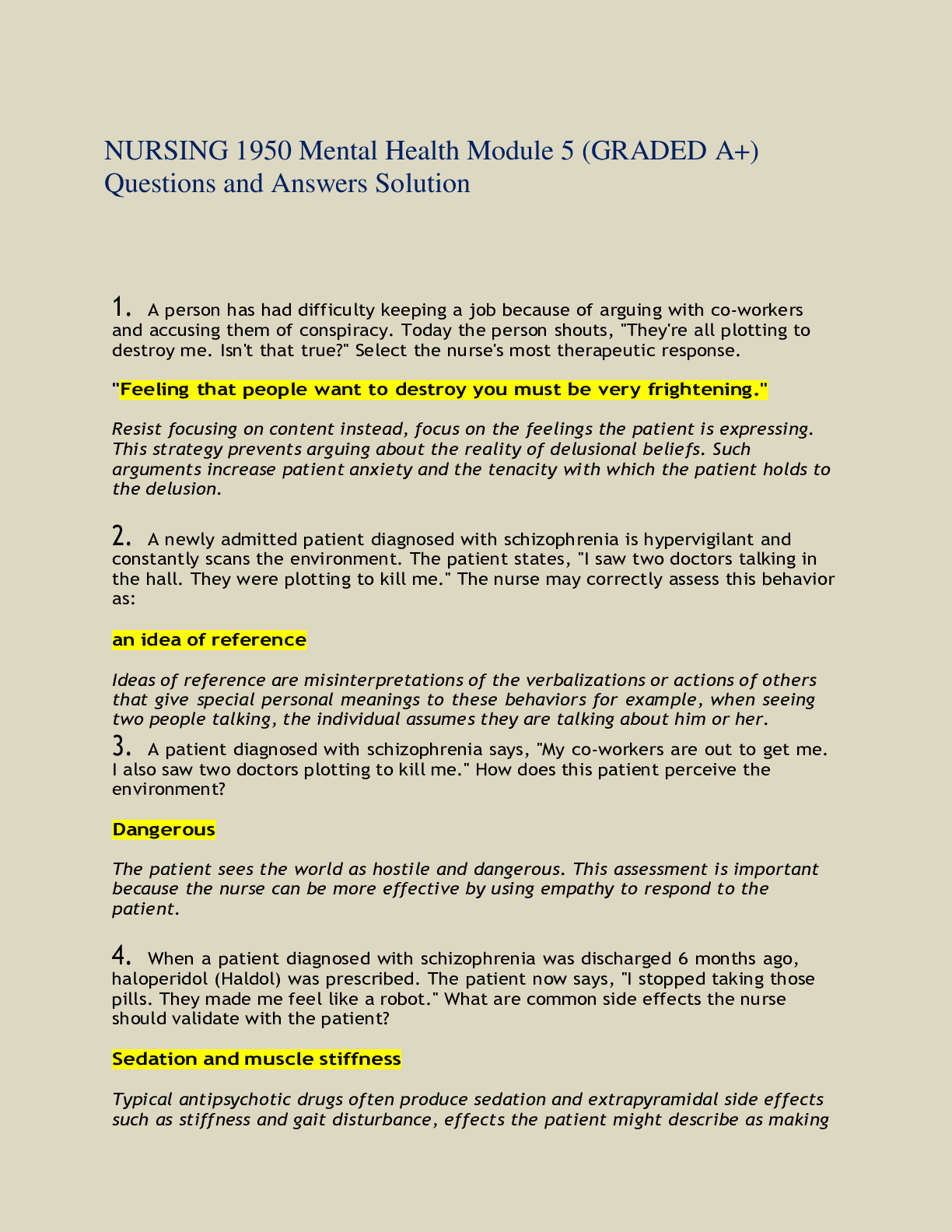
Buy this document to get the full access instantly
Instant Download Access after purchase
Buy NowInstant download
We Accept:

Also available in bundle (1)
Click Below to Access Bundle(s)
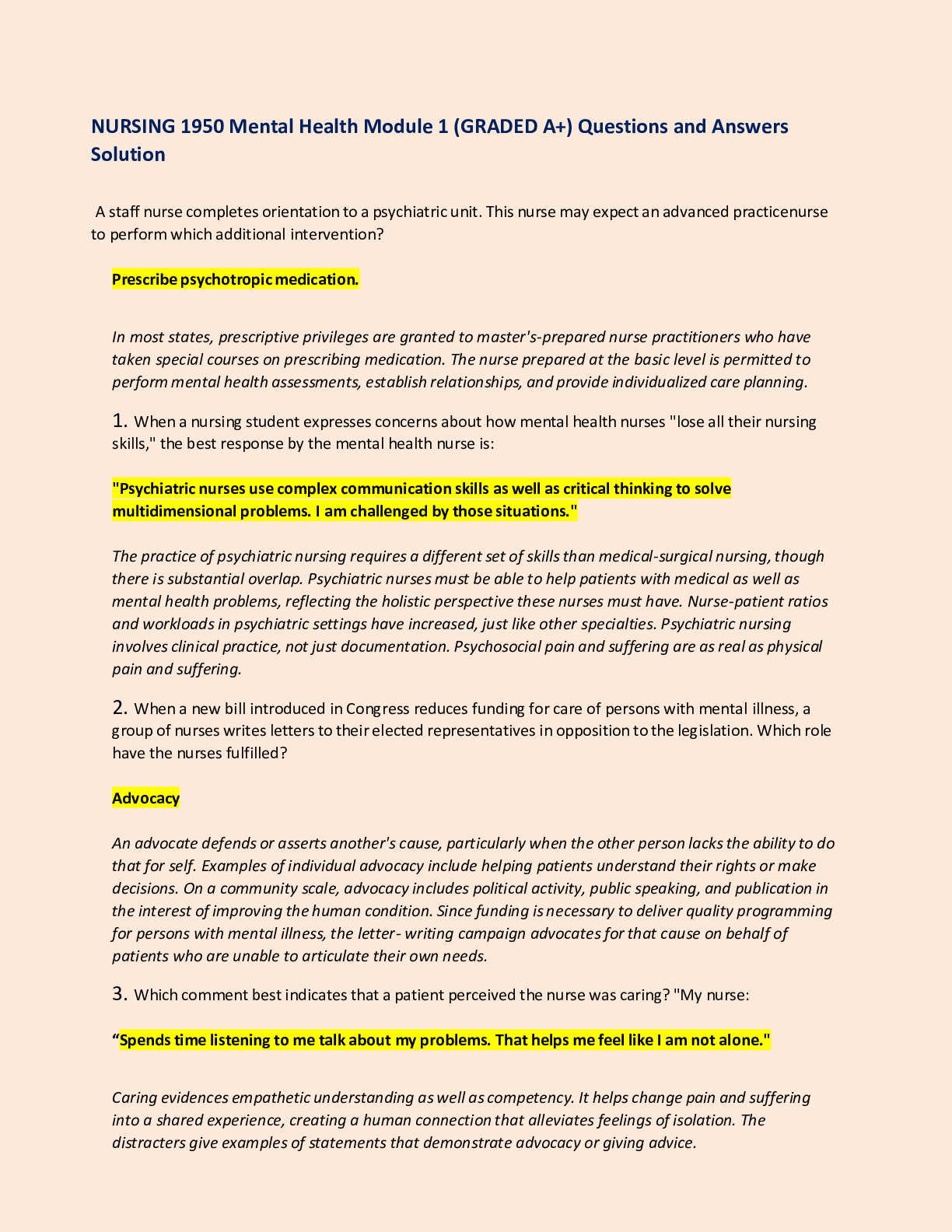
Nursing 1950 Mental Health Module BUNDLE Exams 1-6 with Questions and Answers- SRTC
Nursing 1950 Mental Health Module BUNDLE Exams 1-6 with Questions and Answers- SRTC
By Prof. Goodluck 4 years ago
$14.5
6
Reviews( 0 )
$16.00
Can't find what you want? Try our AI powered Search
Document information
Connected school, study & course
About the document
Uploaded On
Jun 24, 2021
Number of pages
27
Written in
All
Additional information
This document has been written for:
Uploaded
Jun 24, 2021
Downloads
0
Views
138


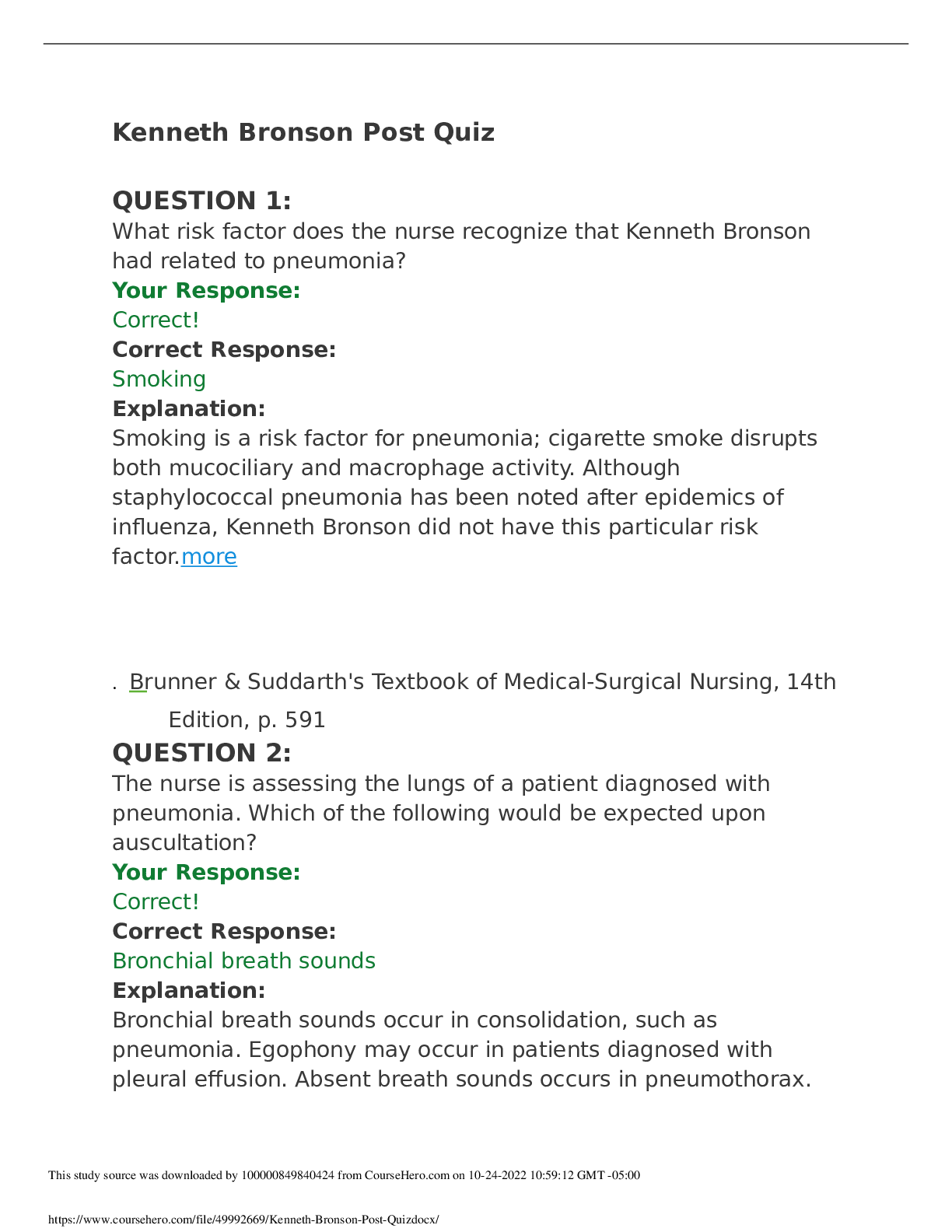



 Questions and Answers 100% VERIFIED.png)
 Questions and Answers 100% correct Solutions.png)





